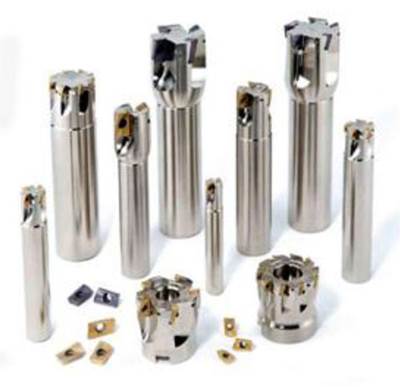This installment will outline the current state of tool material and coating technologies and discuss the factors driving new milling grades.
New Milling Challenges
Two main factors driving development of new milling tool materials and coatings are the ongoing evolution of new workpiece materials and milling processes and technologies designed to address them.
New workpiece materials are being developed in response to many factors. These include ever-increasing global demand for bigger, faster, and affordable modes of transportation (automobiles, airplanes, and so on), coupled with growing concerns for green and renewable energy sources, high performance components, and higher safety standards.
Development of these new alloys has always been one of the main drivers of new cutting tool technologies and grades. Work materials such as austenitic and martensitic stainless steels, compacted graphite iron (CGI), austempered ductile iron (ADI), nickel-based superalloys , titanium alloys, and metal-matrix composites are finding extensive applications in aircraft engine and structural components, gas and steam turbine components, high-performance automobiles, and space vehicles.
Improved properties that allow parts made from these materials to perform better in their intended application also present special challenges for milling tools. Some of the key properties required for milling tools to machine these high-performance work materials include:
- High hot hardness, i.e., retention of the cutting edge at elevated temperatures near the tool/workpiece interface.
- Ability to withstand high cutting forces during machining.
- Low thermal conductivity to resist edge degradation such as depth-of-cut notching, plastic deformation, and oxidation caused by high temperatures at the cutting edge.
- Chemical inertness to minimize formation of built-up edge (BUE) and the possibility of coating delamination.
- High wear resistance to reduce abrasive wear at the cutting edge due to hard intermetallic compounds in the microstructure.
- Geometry that provides efficient cutting, good chip-breaking, and minimizes heat generation during machining to reduce subsurface defects on the workpiece.
See Figure 1.
Concurrent with the development of new, difficult-to-machine work materials is the desire of machine shops to improve productivity, profit margins, workpiece quality, and shorter lead times. The need for continuous improvement of milling operations has resulted in multiple new production technologies, such as trochoidal milling, dry machining, hard milling, and high-speed cutting (HSC).
All of these factors place added constraints on milling tools. Cutting tool suppliers have responded with new tool materials, coatings, and geometries. Each of these components, separately and together, plays a large role in achieving improved milling efficiency and productivity.
The following sections of this article will focus on the current state of substrate materials and coating technologies and outline their impact on milling tool performance.
Substrates
The substrate material of any milling tool must provide good resistance to plastic deformation and thermal and mechanical shock. For milling, shops can choose from tungsten carbide, cermet, ceramic, and superhard tool materials. Each material type is highly engineered to deliver the properties required for a given application.
Carbides
Produced using powder metallurgy techniques, the most common form of cemented carbide consists of fine particles of tungsten carbide distributed in a binder phase. The relative amount of carbide particles and binder materials used allows cutting tool suppliers to tailor properties to meet a wide variety of application requirements. The more binder material — most commonly cobalt — a tool contains, the tougher the tool. Conversely, higher percentages of carbide particles in relation to binder make the tool material harder at the expense of toughness.
Another important factor in the tradeoff between tool toughness and hardness is particle size of the P/M materials used. Carbides are available in three grain-size ranges: fine grain (average grain size of 0.8-1.3 µm), submicron (0.5-0.8 µm), and ultra-fine grain (average grain size 0.2-0.5 µm). Finer grain sizes yield materials with higher hardness and toughness. See Figure 2.
Using different hard particles and binder materials allows cutting-tool manufacturers to engineer application-specific tool materials. Ongoing processing refinements also are resulting in cemented carbide tools with a cobalt-enriched layer near the insert surface. This layer, which may have two to three times the cobalt concentration of the bulk material, improves toughness at the tool surface while maintaining hardness and wear resistance in the remainder of the tool.
Figure 3--Effects of Various Hard Particle Materials on Cutting Tool Properties
Constituent Property Effect
Co, Ni , Fe binder materials Toughness, corrosion resistance
WC hard particles Hardness, good wettability by cobalt
TiC, TiCN hard particles Higher hardness, lower thermal conductivity
and lower solubility in iron alloys than WC
(Ta, Nb)C Improved high-temperature properties and thermal shock resistance
VC, Cr3C2 Grain growth inhibitors in WC-Co materials
Mo2C Improved wettability of TiCN by binder in cermets
|
Cermets are produced using essentially the same techniques as cemented carbides, but use alternative binder and hard particle materials. Binder materials may be a mix of cobalt, nickel, and iron, and hard materials may include titanium carbide (TiC), titanium carbonitride (TiCN), and carbides of tantalum, vanadium, chromium, or niobium.
Cermets generally are harder and more wear-resistant than cemented carbides but have lower strength and toughness. Cermet materials are applicable for semi-finish and finish milling in a variety of materials, including stainless and alloy steels.
Ceramics. Even harder and more non-reactive than cermets are ceramic materials, which can run hotter and wear longer than carbides or cermets in some applications. Ceramic milling tools can withstand far more heat than carbides, and, in fact, high heat is essential if ceramic tooling is to function properly in milling of very hard work materials.
There are two broad categories of ceramic cutting tool materials: those based on alumina (Al2O3) and those based on silicon nitride (Si3N4). Alumina-based compositions include white ceramic, a blend of alumina and zirconia (ZrO2); black ceramic, a mix of alumina, zirconia and TiC or TiCN hard particles; and whisker-reinforced materials, which consist of silicon carbide (SiC) whiskers in an alumina matrix.
Silicon nitride-based materials include Si3N4 and sialon materials, which incorporate both Al2O3 and Si3N4. Silicon nitride has good toughness and strength and very good thermal shock resistance, and silicon nitride tools are applicable for milling and other interrupted-cut operations on gray iron.
Sialons have a low coefficient of thermal expansion and high thermal conductivity, which provide very good resistance to thermal shock and thermal fatigue. They are well-suited for milling of superalloy workpieces.
Superhard Materials. At the pinnacle of milling tool materials in terms of hardness and wear resistance are superhard grades, including multiple forms of diamond and cubic boron nitride (CBN). Diamond-based materials include polycrystalline diamond (PCD) and diamond coatings deposited by a variety of methods.
In PCD tooling, diamond tips consisting of fine diamond particles in a carbide matrix are brazed to a carbide substrate. Diamond films and sheets are layers of pure diamond deposited using chemical vapor deposition (CVD) on a carbide substrate.
The chief limitation of diamond cutting tool materials--whether PCD or thick-film--is their tendency to react with ferrous alloys. This limitation is what led to initial development of CBN tool materials.
On the continuum of tool material hardness, CBN (Knoop microhardness 4,500 kg/mm2) is surpassed in hardness only by diamond (7,000 kg/mm2). Cubic boron nitride tools are produced using a process similar to that used to make PCD tooling. Used to machine very hard ferrous materials such as hardened alloy steels, sintered irons, hardened cast irons, and case-hardened materials, CBN grades can handle a variety of operations including milling of hardened steels.
Milling Tool Coatings
In milling tools, the substrate material provides the hardness and toughness needed to withstand the interrupted cutting inherent to milling processes. However, without the right coatings, even the best milling inserts would suffer from poor machining performance and shortened tool life.
Coating of cutting tools began decades ago with titanium nitride (TiN), the familiar gold-colored material still seen on many cutting tools. Ongoing research has resulted in development of a much wider array of coating materials deposited by several methods. Titanium nitride is now used as a kind of general-purpose coating and is sometimes applied as a wear-indicating top coat in increasingly common multi-layer coating systems. Other coating materials for milling tools include TiCN, TiC, titanium aluminum nitride (TiAlN), Al2O3, and titanium diboride (TiB2).
These materials, as shown in Figure 4, can be applied in successive layers to achieve a synergistic effect on tool life and cutting efficiency not possible from a mono-layer coating, and cutting tool manufacturers have developed sophisticated combinations of coatings to achieve this end. For example, one coating system developed for milling inserts consists of a thin (<1 µm) top coat of TiN used as a wear indicator, a relatively thick layer of Al2O3 5-8 µm thick for resistance to chemical and thermal wear, and a thick TiCN layer to resist adhesive and abrasive wear. Between the latter two layers is a very thin interlayer that improves adhesion of the Al2O3 layer to the TiCN.
Cutting tool suppliers can choose from several coating deposition methods that impact the final properties not only of the coatings themselves but also of the carbide substrate in milling inserts. These include chemical and physical vapor deposition (CVD and PVD) and medium-temperature CVD (MTCVD). The following table compares the attributes and capabilities of the CVD and PVD processes.
Attributes of PVD and CVD Coating Processes
Attribute PVD CVD
Deposition Temperature, ºC 400-600 850-1,000
Deposition Rate, µm/hr 0.5-1 1-1.5
Total Thickness, µm 0.5-7 5-25
Thickness Uniformity Non-uniform Uniform
Stress of Coating Layer Compressive Tensile depending on
thermal expansion
coefficient;
compressive after
post-coat
blasting treatment
Post-Coat Treatment Brushing/blasting Brushing/blasting
Applications Round tools, inserts Inserts
A key differentiator of the two processes is deposition temperature. As shown in the above table, CVD processing temperatures are roughly double those required for PVD. This relatively high process temperature ensures good adhesion of the coating to the substrate material. However, it also can cause microstructural changes in the substrate material that can reduce tool life if not addressed with a post-coating treatment.
In PVD, process temperatures are much lower than those used in PVD, thus avoiding potential changes in substrate microstructure. PVD is a line-of-sight process that requires moving fixtures to ensure uniform coating thickness. This attribute also varies coating thickness on different parts of the inserts being coated, enabling application of a thicker coating on surfaces that experience more wear and allowing application of PVD coatings on sharp insert edges.
See Figure 5.
PVD coatings tend to have built-in compressive stresses that help them resist crack initiation and propagation; CVD coatings, in contrast, are formed with inherent tensile stresses. Cutting tool suppliers are addressing this issue using a variety of post treatments to put CVD coating materials into compressive stress, reduce surface roughness, and provide a longer, more predictable tool life.
One such treatment consists of brushing or blasting of the outer layer of a multi-layer (fine-grained Al2O3 over TiCN) CVD coating followed by micro-polishing of the tool edges. The initial post-treatment reduces stresses in the coating to decrease susceptibility to micro-chipping, notching and thermal cracking and provide a longer, more predicable tool life. Micro-polishing improves edge toughness and reduces cutting forces, friction, and workpiece sticking.
Regardless of the material or the deposition method, all tool coatings are designed to perform the same functions: improving the chemical and thermal stability of the cutting tool to allow faster milling and a longer, more predictable tool life. Improved chemical stability results in better resistance to diffusion wear and oxidation; improved thermal stability translates to better hot hardness, improved resistance to abrasive wear and higher cutting speeds.
Ongoing advances in tool materials and coatings, coupled with more efficient tool production technologies, are enabling cutting tool suppliers to provide optimized application-specific milling tools precisely tailored to the needs of end users. With careful selection of cutter and insert geometry, such advanced tools can result in dramatic improvements in milling speed, workpiece quality, and tool life.
Editor’s note: You can read the next part by clicking here.


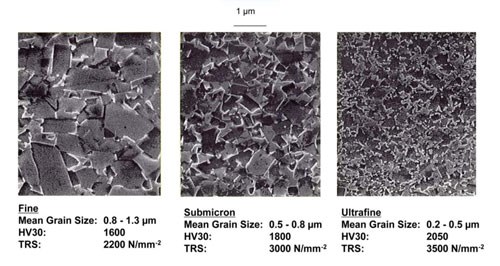
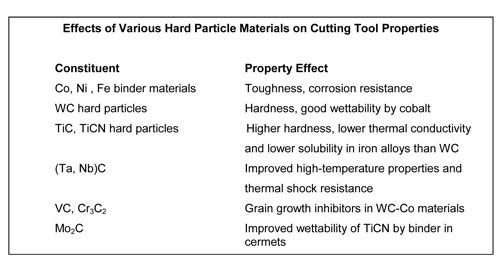
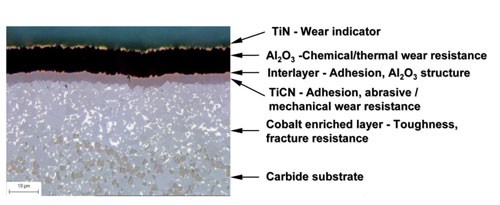
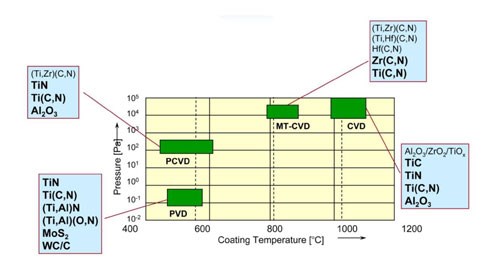
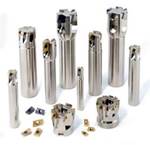










.png;maxWidth=300;quality=90)




.png;maxWidth=300;quality=90)






